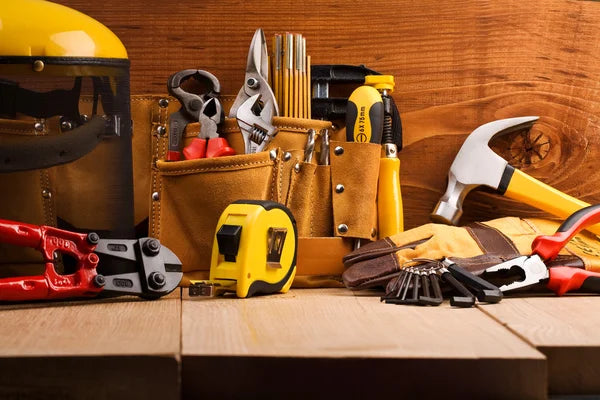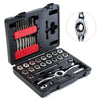
When to Upgrade: 7 Signs Your Workshop Tools Need Replacement
As a dedicated craftsman or DIY enthusiast, your workshop tools are essential to the quality and efficiency of your projects. However, like all things in life, tools have a lifespan and eventually need to be replaced. Knowing when to upgrade your workshop tools is crucial to maintaining optimal performance and safety. In this blog post, we will explore the key signs that indicate it's time to replace your power tools and hand tools. By recognizing these signs early on, you can ensure that your workshop is equipped with tools that support your craftsmanship and creativity. Let's dive into the world of workshop tool maintenance and upgrades to keep your projects running smoothly.
Introduction: Understanding the Life Cycle of Workshop Tools
Tools are essential companions for any craftsman or DIY enthusiast, aiding in the creation of magnificent projects. However, just like any other equipment, workshop tools have a finite lifespan. Understanding the life cycle of these tools is crucial in determining when it's time for an upgrade.
Every tool has a certain period of usefulness, which can vary depending on factors such as quality, usage frequency, and maintenance. Initially, when a tool is new, it performs at its peak, delivering excellent results and ensuring efficient work. However, over time, wear and tear take their toll, impacting the tool's performance and effectiveness.
It's important to acknowledge that not all tools have the same life expectancy. Power tools, with their complex internal components and motors, may have a shorter lifespan compared to hand tools, which are typically simpler and more durable. Understanding these differences can help you assess the condition of your tools more accurately.
In the following sections, we will delve into the signs that indicate when it's time to upgrade your workshop tools. By recognizing these signs and understanding the life cycle of your tools, you can make informed decisions regarding maintenance, repairs, and replacements, ensuring that your workshop is always equipped with tools that meet your needs and deliver exceptional results.
Related Article: The Ultimate Guide to Workshop Tools
Signs Your Power Tools Need Replacement
Power tools play a crucial role in any workshop, providing the necessary power and precision to tackle a wide range of tasks. However, as these tools age and endure extensive use, they may start to exhibit signs that indicate the need for replacement. Here are some key signs to look out for:
Decreased Performance and Efficiency
One of the most evident signs that your power tools need replacement is a noticeable decline in performance and efficiency. If you find that your tools are struggling to complete tasks that they used to handle with ease, it may be an indication that their internal components are wearing out or malfunctioning. Slower operation, reduced power output, and diminished cutting or drilling capabilities are all signs that your power tools may need to be upgraded.
Excessive Noise or Vibration
Power tools that produce excessive noise or vibration beyond their normal operating levels may be indicating a problem. These issues can be a result of worn-out bearings, loose parts, or motor malfunctions. Not only can excessive noise and vibration be disruptive and uncomfortable to work with, but they may also indicate potential safety hazards. If your power tools are becoming increasingly noisy or vibrating excessively, it's advisable to consider replacing them.
Frequent Breakdowns or Malfunctions
If you find yourself frequently dealing with power tool breakdowns or malfunctions, it's a clear sign that they are reaching the end of their lifespan. Constant repairs and downtime can significantly hinder your productivity and increase project completion time. Additionally, the cost of repairs may become excessive, making it more cost-effective to invest in new tools instead.
Visible Damage or Wear and Tear
Inspect your power tools regularly for any visible damage or signs of wear and tear. Cracked or frayed power cords, damaged switches or handles, and worn-out brushes are all indications that your tools may need replacement. Such damage compromises not only the tool's functionality but also poses potential safety risks. It's essential to address these issues promptly and consider upgrading to ensure a safe and efficient working environment.
Obsolete Model or Technology
As technology advances, power tools continually evolve to offer improved features, performance, and safety enhancements. If you find that your power tools are outdated and lack the latest advancements, it may be time to consider upgrading to newer models. Newer tools often come with enhanced functionalities, improved ergonomics, and increased energy efficiency, allowing you to work more effectively and efficiently.
By recognizing these signs of deterioration in your power tools, you can make informed decisions about when it's time to upgrade. Upgrading to newer and more advanced power tools not only ensures better performance and productivity but also enhances safety in your workshop.
Related Article: Power Tools Explained: A Beginner’s Guide
Signs Your Hand Tools Need Replacement
Hand tools are the backbone of any workshop, providing precision and control for various tasks. Although they may not have the same complexity as power tools, hand tools can also show signs of wear and deterioration over time. Here are some key signs that indicate your hand tools may need replacement:
Rust and Corrosion
One of the primary signs that your hand tools need replacement is the presence of rust and corrosion. Exposure to moisture, humidity, or improper storage can cause metal tools to rust, compromising their structural integrity and functionality. Rusty tools are not only less effective but can also leave stains or marks on your workpieces. If cleaning and maintenance fail to restore your tools, it's time to consider replacing them.
Broken or Loose Handles
Handles that are broken, cracked, or loose significantly affect the usability and safety of hand tools. Loose handles can cause instability and compromise your control over the tool, increasing the risk of accidents. Cracked or broken handles not only hinder your ability to grip and maneuver the tool effectively but can also cause discomfort or blisters during prolonged use. When handles are damaged beyond repair, it's advisable to replace the hand tools to maintain optimal performance and safety.
Dull or Worn Out Blades
Hand tools with dull or worn-out blades can lead to subpar results and frustration. Whether it's a saw with a dull blade, a chisel with a chipped edge, or a screwdriver with a worn-out tip, compromised cutting or gripping surfaces can make your tasks more challenging and time-consuming. Attempting to use such tools can also increase the risk of accidents. If sharpening or honing the blade no longer restores its effectiveness, it's a clear indication that it's time for a replacement.
Misaligned or Bent Components
Inspect your hand tools for misaligned or bent components, such as jaws, blades, or prongs. Misalignment can affect the accuracy and precision of your work, leading to unsatisfactory results. Bent components not only compromise functionality but can also pose safety risks. Attempting to straighten or force them back into position may further damage the tool or result in an unreliable tool. In such cases, it's best to replace the hand tool with a properly functioning one.
By recognizing these signs of wear and deterioration in your hand tools, you can ensure that your workshop remains equipped with tools that deliver the precision and control necessary for your projects. Replacing worn-out hand tools not only enhances your efficiency and work quality but also contributes to a safer working environment.
Related Article: Top 5 Budget-Friendly Power Tool Brands



